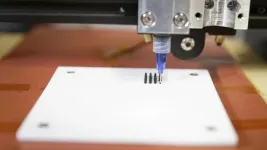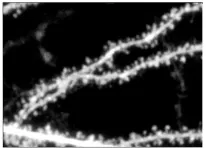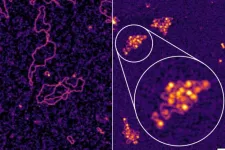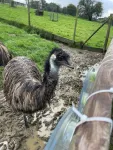(Press-News.org) Rapid, localized heat management is essential for electronic devices and could have applications ranging from wearable materials to burn treatment. While so-called thermoelectric materials convert temperature differences to electrical voltage and vice versa, their efficiency is often limited, and their production is costly and wasteful. In a new paper published in Science, researchers from the Institute of Science and Technology Austria (ISTA) used a 3D printing technique to fabricate high-performance thermoelectric materials, reducing production costs significantly.
Thermoelectric coolers, also called solid-state refrigerators, can induce localized cooling by using an electric current to transfer heat from one side of the device to another. Their long lifetimes, invulnerability to leaks, size and shape tunability, and the lack of moving parts (such as circulating liquids) make these devices ideal for diverse cooling applications, such as electronics. However, manufacturing them out of ingots is associated with high costs and generates lots of material waste. In addition, the devices’ performance remains limited.
Now, a team at the Institute of Science and Technology Austria (ISTA), led by Verbund Professor for Energy Sciences and Head of the Werner Siemens Thermoelectric Laboratory Maria Ibáñez, with first author and ISTA postdoc Shengduo Xu, developed high-performance thermoelectric materials out of the 3D printer and used them to build a thermoelectric cooler. “Our innovative integration of 3D printing into thermoelectric cooler fabrication greatly improves manufacturing efficiency and reduces costs,” says Xu. Also, in contrast to previous attempts at 3D printing thermoelectric materials, the present method yields materials with considerably higher performance. ISTA Professor Ibáñez adds, “With commercial-level performance, our work has the potential to extend beyond academia, holding practical relevance and attracting interest from industries seeking real-world applications.”
Pushing the boundaries of thermoelectric technologies
While all materials demonstrate some thermoelectric effect, it is often too negligible to be useful. Materials exhibiting a high enough thermoelectric effect are usually so-called “degenerate semiconductors,” i.e., “doped” semiconductors, to which impurities are introduced intentionally so they behave like conductors. Current state-of-the-art thermoelectric coolers are produced using ingot-based manufacturing techniques—expensive and power-hungry procedures requiring extensive machining processes after production, where a lot of material is wasted. “With our present work, we can 3D print exactly the needed shape of thermoelectric materials. In addition, the resulting devices exhibit a net cooling effect of 50 degrees in the air. This means that our 3D-printed materials perform similarly to ones that are significantly more expensive to manufacture,” says Xu. Thus, the team of ISTA material scientists proposes a scalable and cost-effective production method for thermoelectric materials, circumventing energy-intensive and time-consuming steps.
Printed materials with optimized particle bonding
Beyond applying 3D printing techniques to produce thermoelectric materials, the team designed the inks so that, as the carrier solvent evaporates, effective and robust atomic bonds are formed between grains, creating an atomically connected material network. As a result, the interfacial chemical bonds improve the charge transfer between grains. This explains how the team managed to enhance the thermoelectric performance of their 3D-printed materials while also shedding new light on the transport properties of porous materials. “We employed an extrusion-based 3D printing technique and designed the ink formulation to ensure the integrity of the printed structure and boost particle bonding. This allowed us to produce the first thermoelectric coolers from printed materials with comparable performance to ingot-based devices while saving material and energy,” says Ibáñez.
Medical applications, energy harvesting, and sustainability
Beyond rapid heat management in electronics and wearable devices, thermoelectric coolers could have medical applications, including burn treatment and muscle strain relief. In addition, the ink formulation method developed by the team of ISTA scientists can be adapted for other materials to be used in high-temperature thermoelectric generators—devices that can generate electrical voltage from a temperature difference. According to the team, such an approach could broaden the applicability of thermoelectric generators across various waste energy harvesting systems.
“We successfully executed a full-cycle approach, from optimizing the raw materials’ thermoelectric performance to fabricating a stable, high-performance end-product,” says Ibáñez. Xu adds, “Our work offers a transformative solution for thermoelectric device production and heralds a new era of efficient and sustainable thermoelectric technologies.”
END
Cooling materials – Out of the 3D printer
ISTA researchers 3D print high-performance, sustainable thermoelectric materials
2025-02-20
ELSE PRESS RELEASES FROM THIS DATE:
New knowledge portal adiposetissue.org enhances obesity and metabolism research with centralized data
2025-02-20
Addressing the Challenge of Dispersed Data
For years, adipose tissue research has generated vast amounts of omics data, but these datasets remained scattered across different repositories, making comprehensive analysis challenging. Adiposetissue.org now brings insights together, integrating transcriptomic and proteomic with clinical data from more than 6,000 individuals, enabling researchers to explore obesity-related changes, weight-loss effects, and cellular mechanisms with unprecedented depth.
“We developed ...
Study suggests new molecular strategy for treating fragile X syndrome
2025-02-20
Building on more than two decades of research, a study by MIT neuroscientists at The Picower Institute for Learning and Memory reports a new way to treat pathology and symptoms of fragile X syndrome, the most common genetically-caused autism spectrum disorder. The team showed that augmenting a novel type of neurotransmitter signaling reduced hallmarks of fragile X in mouse models of the disorder.
The new approach described in Cell Reports works by targeting a specific molecular subunit of “NMDA” receptors that they discovered plays a key role in how neurons synthesize ...
Digging into a decades-old hepatitis B mystery suggests a new potential treatment
2025-02-20
In their effort to answer a decades-old biological question about how the hepatitis B virus (HBV) is able to establish infection of liver cells, research led by Memorial Sloan Kettering Cancer Center (MSK), Weill Cornell Medicine, and The Rockefeller University identified a vulnerability that opens the door to new treatments.
The team successfully disrupted the virus’s ability to infect human liver cells in the laboratory using a compound already in clinical trials against cancer — laying the ...
Big birds like emus are technical innovators, according to University of Bristol researchers
2025-02-20
Large birds – our closest relations to dinosaurs - are capable of technical innovation, by solving a physical task to gain access to food.
This is the first time scientists have been able to show that palaeognath birds such as emus and rheas can solve tricky problems.
In the study, published today in Scientific Reports, emus, which have previously been called the ‘world’s dumbest bird’ were able to create one new technique to access food (lining up a hole with a food chamber) and moved the hole in the most efficient direction towards food in 90% of cases. A male rhea ...
Hidden genetic causes of congenital heart disease identified
2025-02-20
New York, NY [February 20, 2025]—Scientists at the Icahn School of Medicine at Mount Sinai and collaborators have identified novel genetic interactions that may contribute to congenital heart disease (CHD), a common birth defect. Details on their findings were reported in the February 20 online issue of The American Journal of Human Genetics [DOI: 10.1016/j.ajhg.2025.01.024].
“Our research reveals the potential for digenic inheritance—where two genes work together to cause disease—expanding our understanding of the genetic underpinnings of congenital heart ...
Semaglutide and nonarteritic anterior ischemic optic neuropathy
2025-02-20
About The Study: The results of this study suggest a modest increase in the risk of nonarteritic anterior ischemic optic neuropathy among individuals with type 2 diabetes associated with semaglutide use, smaller than that previously reported, and warranting further investigation into the clinical implications of this association.
Corresponding Author: To contact the corresponding author, Cindy X. Cai, MD, MS, email ccai6@jhmi.edu.
To access the embargoed study: Visit our For The Media website at this link https://media.jamanetwork.com/
(doi:10.1001/jamaophthalmol.2024.6555)
Editor’s ...
Inequities in the application of behavioral flags for hospitalized pediatric patients
2025-02-20
About The Study: This cohort study found significant inequities in incidence of behavioral flags in the electronic health record among racially and socioeconomically marginalized pediatric patients. This finding was most pronounced for Black or African American patients younger than 8 years, suggesting that this phenomenon may be a response to Black families rather than specific patient behavior.
Corresponding Author: To contact the corresponding author, April Edwell, MD, MAEd, email April.edwell@ucsf.edu.
To access the embargoed study: Visit our For The Media website at this link https://media.jamanetwork.com/
(doi:10.1001/jamanetworkopen.2024.61079)
Editor’s ...
Paxlovid’s impact on hospitalization and death in COVID-vaccinated older adults far weaker than previously thought
2025-02-20
Paxlovid does not significantly reduce COVID-19 hospitalization and mortality among vaccinated older adults, according to new UCLA-led research.
The study questions the assumption that Paxlovid’s effectiveness in reducing COVID-19 hospitalizations and deaths in unvaccinated adults also applies to vaccinated adults. Pfizer’s 2022 clinical trial found reduced COVID-19 hospitalization in unvaccinated middle-aged adults; while a subsequent 2024 clinical trial found no significant reduction in vaccinated middle-aged adults. Since most older Americans have already received two or more COVID-19 vaccines, Paxlovid’s effectiveness on vaccinated ...
Additive manufacturing of biomedical metals for medical implant fabrication
2025-02-20
Biomedical metal implant materials are widely used in clinical applications, including dental implants, hip replacement, bone plates, and screws. However, traditional manufacturing processes face limitations in meeting customized medical needs, internal structural control, and efficient material utilization. For example, when producing complex-shaped titanium alloy parts using conventional methods, the material consumption ratio is as high as 10:1-20:1, leading to significant material waste.
As a result, ...
Antioxidant-enzyme Interaction in non-communicable diseases
2025-02-20
Introduction
Oxidative stress, caused by an imbalance between reactive oxygen species (ROS) and antioxidant defenses, plays a central role in the development of non-communicable diseases (NCDs). These diseases, including cardiovascular disorders, diabetes, neurodegenerative conditions, cancer, and liver and kidney diseases, are among the leading causes of morbidity and mortality worldwide. Enzymatic and non-enzymatic antioxidants serve as the body’s primary defense against ROS, maintaining redox homeostasis and preventing cellular damage. However, when ROS levels exceed the capacity of antioxidant defenses, oxidative stress ensues, contributing ...
LAST 30 PRESS RELEASES:
University of Oklahoma researcher awarded funding to pursue AI-powered material design
Exploring how the visual system recovers following injury
Support for parents with infants at pediatric check-ups leads to better reading and math skills in elementary school
Kids’ behavioral health is a growing share of family health costs
Day & night: Cancer disrupts the brain’s natural rhythm
COVID-19 vaccination significantly reduces risk to pregnant women and baby
The role of vaccination in maternal and perinatal outcomes associated with COVID-19 in pregnancy
Mayo Clinic smartwatch system helps parents shorten and defuse children's severe tantrums early
Behavioral health spending spikes to 40% of all children’s health expenditures, nearly doubling in a decade
Digital cognitive behavioral treatment for generalized anxiety disorder
Expenditures for pediatric behavioral health care over time and estimated family financial burden
Air conditioning in nursing homes and mortality during extreme heat
The Alps to lose a record number of glaciers in the next decade
What makes a good proton conductor?
New science reporting guide published for journalists in Bulgaria
New international study reveals major survival gaps among children with cancer
New science reporting guide published for journalists in Turkey
Scientists develop a smarter mRNA therapy that knows which cells to target
Neuroanatomy-informed brain–machine hybrid intelligence for robust acoustic target detection
Eight SwRI hydrogen projects funded by ENERGYWERX
The Lundquist Institute and its start-up company Vitalex Biosciences Announces Strategic Advancement of Second-Generation fungal Vaccine VXV-01 through Phase 1 Trials under $40 Million Competitive Con
Fine particles in pollution are associated with early signs of autoimmune disease
Review article | Towards a Global Ground-Based Earth Observatory (GGBEO): Leveraging existing systems and networks
Penn and UMich create world’s smallest programmable, autonomous robots
Cleveland researchers launch first major study to address ‘hidden performance killer’ in athletes
To connect across politics, try saying what you oppose
Modulating key interaction prevents virus from entering cells
Project explores barriers to NHS career progression facing international medical graduates
Jeonbuk National University researchers explore the impact of different seasonings on the flavor perception of Doenjang soup
Two Keck Medicine of USC Hospitals named Leapfrog Top Teaching Hospitals
[Press-News.org] Cooling materials – Out of the 3D printerISTA researchers 3D print high-performance, sustainable thermoelectric materials







